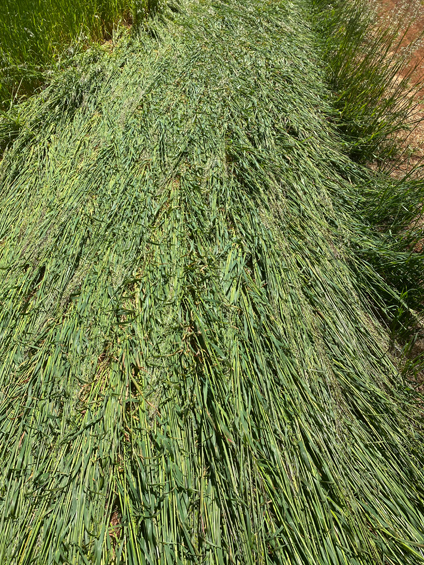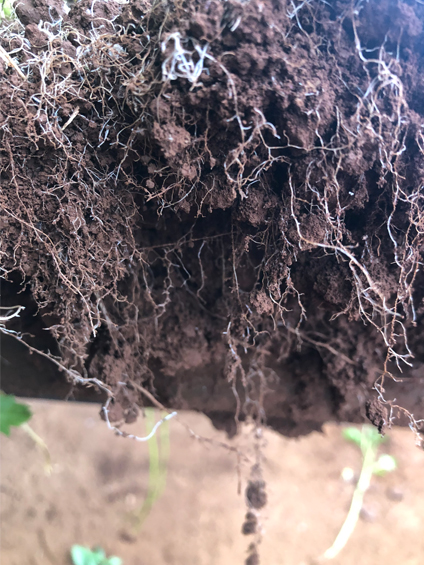Cover cropping pioneer aiming to educate others
In mid-2017, a project was established to support Australian vegetable growers to effectively use cover crops to boost soil health and reap productivity benefits. Vegetables Australia speaks with long-time cover crop advocate, MG Farm’s Darren Long, who has been involved in cover crop coaching clinics as part of this project.
For over 20 years, Tasmanian potato grower Darren Long has been involved in cover cropping and biofumigation, which is the use of specialised cover crops that are grown, mulched and incorporated into the soil prior to cropping.
Darren, who runs the family-owned operation in Sheffield on Tasmania’s north-west coast, has been hailed by others as a leader in this field. Along with Dave Roberts-Thompson from Table Cape Tulip Farm, Darren successfully established Soil First Tasmania in 2016 to educate other growers about cover cropping and other innovative growing practices. Premium Fresh Tasmania Farm Manager Deon Gibson said that he was inspired by Darren to revive cover cropping on his property when interviewed for the 2018 Vegetable Grower Success Stories.
Both growers have been actively involved in a project led by Applied Horticultural Research scientist Dr Kelvin Montagu entitled Optimising cover cropping for the Australian vegetable industry (VG16068), a strategic levy investment under the Hort Innovation Vegetable Fund. Darren has been taking the opportunity to collaborate with growers involved in this project and pass on the knowledge that he has gained over the past two decades.


Early days
Darren’s cover crop investigation began in the 1990s when he heard that Western Australian growers were using brassica crops to control potato-related diseases.
“We went out on our own to try and replicate what Western Australia was doing in controlling diseases with using plants or cover crops, rather than using chemicals,” Darren says.
However, the early years initially proved unsuccessful and Darren found that the plants weren’t controlling the disease. But there were other benefits, located deeper into the soil.
“What we were finding was that we were getting really good soil health with free-draining organic matter, which went in our favour. We were using less water, less fertiliser, and eventually we cracked the code that it wasn’t the plants that were providing the disease control, it was the soils. We were finding a healthier soil that is able to tolerate these diseases,” Darren says.
“The advancements in cover cropping have been the most advanced single change to farming that I’ve seen for 30 years. It’s an absolute game-changer,”
Getting involved
The easiest avenue to learn about different growing practices, such as cover cropping, is to speak to other growers, according to Darren. Through his involvement in VG16068, he has attended cover crop coaching clinics where he has spoken to his peers and those involved in this project.
“I learn more off Deon (Gibson) than he learns off me. It’s that collaboration: talking to a grower without the scientific background and just making it work on our farms. Because it’s really easy to send them a brochure and search the internet but to put things into practice is really difficult. Farming has become such a tight operation and you can’t afford mistakes,” Darren says.
“I think the biggest advantage of these cover crop coaching clinics and having the Hort Innovation projects is that we get to talk to other growers. You can bounce some ideas off each other and that’s what I’ve found – I get to go away and meet growers all around Australia that are like-minded, and we can actually talk about how they do things and what they see.”
Future learnings
While Darren is guiding other vegetable growers along their journey into cover cropping, he is also gaining his own knowledge from Dr Montagu and his research team’s findings.
“The biggest learning curve that we’re getting out of Kelvin’s research is what’s available and what is beneficial to the soil, how it works and the different types of root systems,” Darren says.
“The exposure to all of these new cover crops is taking out the guess-work. We can access material where the research tells us the companion plants that work well, which means we don’t have to guess what will work or not.
“We’re also starting to nail down the seeding rates we need for which cover crop. Growers can use a template – they’ve got a 20-hectare plot and they know what the seeding rate would be to get the best advantages out of that. We’ve also found other materials that we didn’t know existed, like tick bean and other types of new species, that we can use in our cover crop.”

Rapid advancement
Darren is surprised at how quickly cover cropping practices have changed, particularly over the past three years.
“The advancements in cover cropping have been the most advanced single change to farming that I’ve seen for 30 years. It’s an absolute game-changer,” he says.
“We haven’t really increased yields; the savings are at pack-out and reducing input costs to produce the crop, and we’re at a stage now where we don’t even use fungicides or insecticides, and we’re nearly at a point where we’re not using herbicides. Brassicas, or the cover crops that we use, are controlling our weed problem.”
To those growers who haven’t adapted to these practices, Darren’s message is clear: Have an open mind.
“You might only implement 10 per cent of what we’re doing to make a change and then you’ll see the differences from there. If you’re a farmer and you want to change and your agronomist won’t let you change, then you need to get a new agronomist,” he says.
“That’s the biggest key for us. We’ve had the one agronomist, Peter Aird from Serve-Ag, for 30 years and he challenges me more than I challenge myself.”
Furthermore, Darren says that it’s important to join these projects to learn some of the terminology and language.
“The key factor there is the communication between researchers and growers. Kelvin’s been good because he gets growers involved, and takes us along so he can talk about the science and we can back it up with how we do it on-farm.
“We need to learn the same language so we know what we’re talking about and we can educate each other.”
Find out more:
Please contact Darren Long on 0408 997 410 or at mgfarm@outlook.com.
More about this project can be found at soilwealth.com.au/about-us/cover-crops-vg16068.
This project has been funded by Hort Innovation using the vegetable research and development levy and contributions from the Australian Government.
Project Number: VG16068
Fast facts: Cover crops used by Darren Long
Caliente 199 – 8 kilograms per hectare
Nemat – four kilograms per hectare
Used prior to main crop
Saia oats – 22 kilograms per hectare
Sown directly after harvest
Buckwheat/ryegrass (summer grown).
Tillage rootmax, ryegrass and saia oats for silage and hay production.
“This is a starting point for readers to try ryegrass, oats and buckwheat rates, which are probably best left to growers’ discretion,” Darren says.
This grower profile first appeared in the leading magazine for the Australian vegetable industry, Vegetables Australia. If you’d like to subscribe to receive a new edition of Vegetables Australia in your mailbox every two months, use our online subscription form!
Photography credit: Belle Young
Crop photos courtesy of Darren Long

